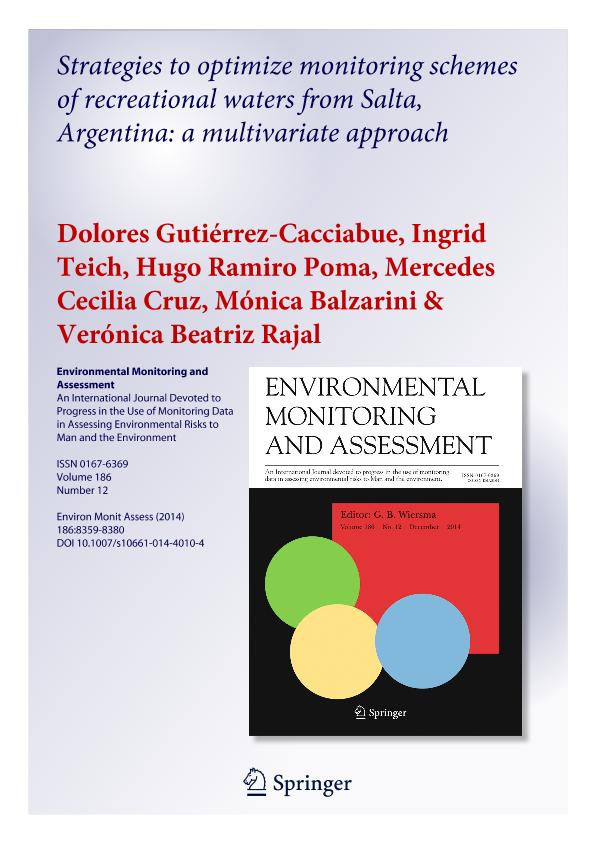Mostrar el registro sencillo del ítem
dc.contributor.author
Gutiérrez Cacciabue, Dolores

dc.contributor.author
Teich, Ingrid

dc.contributor.author
Poma, Hugo Ramiro

dc.contributor.author
Cruz, Mercedes Cecilia

dc.contributor.author
Balzarini, Monica Graciela

dc.contributor.author
Rajal, Verónica Beatriz

dc.date.available
2016-10-20T18:31:37Z
dc.date.issued
2014-08
dc.identifier.citation
Gutiérrez Cacciabue, Dolores; Teich, Ingrid; Poma, Hugo Ramiro; Cruz, Mercedes Cecilia; Balzarini, Monica Graciela; et al.; Strategies to optimize monitoring schemes of recreational waters using a multivariate approach; Springer; Environmental Monitoring And Assessment; 186; 12; 8-2014; 8359-8380
dc.identifier.issn
0167-6369
dc.identifier.uri
http://hdl.handle.net/11336/7758
dc.description.abstract
Several recreational surface waters in Salta, Argentina, were selected to assess their quality. Seventy percent of the measurements exceeded at least one of the limits established by international legislation becoming unsuitable for their use. To interpret results of complex data, multivariate techniques were applied. Arenales River, due to the variability observed in the data, was divided in two: upstream and downstream representing low and high pollution sites, respectively, and cluster analysis supported that differentiation. Arenales River downstream and Campo Alegre Reservoir were the most different environments, and Vaqueros and La Caldera rivers were the most similar. Canonical correlation analysis allowed exploration of correlations between physicochemical and microbiological variables except in both parts of Arenales River, and principal component analysis allowed finding relationships among the nine measured variables in all aquatic environments. Variable?s loadings showed that Arenales River downstream was impacted by industrial and domestic activities, Arenales River upstream was affected by agricultural activities, Campo Alegre Reservoir was disturbed by anthropogenic and ecological effects, and La Caldera and Vaqueros rivers were influenced by recreational activities. Discriminant analysis allowed identification of subgroup of variables responsible for seasonal and spatial variations. Enterococcus, dissolved oxygen, conductivity, E. coli, pH, and fecal coliforms are sufficient to spatially describe the quality of the aquatic environments. Regarding seasonal variations, dissolved oxygen, conductivity, fecal coliforms, and pH can be used to describe water quality during dry season, while dissolved oxygen, conductivity, total coliforms, E. coli, and Enterococcus during wet season. Thus, the use of multivariate techniques allowed optimizing monitoring tasks and minimizing costs involved.
dc.format
application/pdf
dc.language.iso
eng
dc.publisher
Springer

dc.rights
info:eu-repo/semantics/openAccess
dc.rights.uri
https://creativecommons.org/licenses/by-nc-sa/2.5/ar/
dc.subject
Bacterial Indicators
dc.subject
Recreational Uses
dc.subject
Seasonal Behavior
dc.subject
Statistical Analysis
dc.subject
Surface Water
dc.subject.classification
Oceanografía, Hidrología, Recursos Hídricos

dc.subject.classification
Ciencias de la Tierra y relacionadas con el Medio Ambiente

dc.subject.classification
CIENCIAS NATURALES Y EXACTAS

dc.title
Strategies to optimize monitoring schemes of recreational waters using a multivariate approach
dc.type
info:eu-repo/semantics/article
dc.type
info:ar-repo/semantics/artículo
dc.type
info:eu-repo/semantics/publishedVersion
dc.date.updated
2016-03-14T12:50:47Z
dc.journal.volume
186
dc.journal.number
12
dc.journal.pagination
8359-8380
dc.journal.pais
Alemania

dc.journal.ciudad
Berlin
dc.description.fil
Fil: Gutiérrez Cacciabue, Dolores. Consejo Nacional de Investigaciones Científicas y Técnicas. Centro Científico Tecnológico Salta. Instituto de Investigación Para la Industria Química (i); Argentina
dc.description.fil
Fil: Teich, Ingrid. Universidad Nacional de Córdoba. Facultad de Ciencias Agropecuarias; Argentina. Consejo Nacional de Investigaciones Científicas y Técnicas; Argentina
dc.description.fil
Fil: Poma, Hugo Ramiro. Consejo Nacional de Investigaciones Científicas y Técnicas. Centro Científico Tecnológico Salta. Instituto de Investigación Para la Industria Química (i); Argentina
dc.description.fil
Fil: Cruz, Mercedes Cecilia. Consejo Nacional de Investigaciones Científicas y Técnicas. Centro Científico Tecnológico Salta. Instituto de Investigación Para la Industria Química (i); Argentina
dc.description.fil
Fil: Balzarini, Monica Graciela. Universidad Nacional de Córdoba. Facultad de Ciencias Agropecuarias; Argentina. Consejo Nacional de Investigaciones Científicas y Técnicas; Argentina
dc.description.fil
Fil: Rajal, Verónica Beatriz. Consejo Nacional de Investigaciones Científicas y Técnicas. Centro Científico Tecnológico Salta. Instituto de Investigación Para la Industria Química (i); Argentina
dc.journal.title
Environmental Monitoring And Assessment

dc.relation.alternativeid
info:eu-repo/semantics/altIdentifier/url/http://link.springer.com/article/10.1007/s10661-014-4010-4
dc.relation.alternativeid
info:eu-repo/semantics/altIdentifier/doi/http://dx.doi.org/10.1007/s10661-014-4010-4
Archivos asociados
